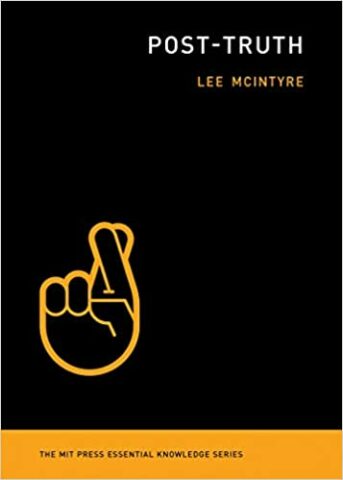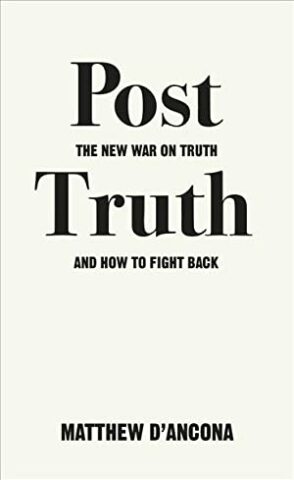Keeping a clear head: your best antidote to the post-truth world
It’s a strikingly topical issue: the legislative initiatives designed to tackle fake news introduced simultaneously in France and Russia in late 2018 clearly reflect the wave of panic that is washing over society. And all this as we’re faced with the decline of scientific and factual truth and the onslaught of alternative facts, conspiracy theories, and other forms of fake news. Whether in the public, political and economic sphere, post-truth spares none. How did we get here and how can we say “Stop: enough is enough”?
Concern about the weaponization of misinformation and post-truths is currently at an all-time high of 76% according to the 2022 Trust Barometer published by Edelman
It’s a portmanteau word that comes in a range of shapes and sizes, including old favorites such as deliberate omission and straightforward lies, together with a handful of newcomers, especially fake news and alternative facts. In the space of a few years, post-truth has become an undeniable star, spawning reams of scholarly publications, innumerable political and press commentaries, several legislative initiatives, and general consternation. How did we get here and how can we say enough is enough?

Post Truth, by Lee McIntyre, (The MIT Press, 2018).

Post Truth : The New War on Truth and How to Fight Back, by Matthew d’Ancona, (Ebury Press, 2017).
Our biases grease the wheels of fake news
Lying is a metaphorical pas de deux: it involves not just “transmitters” but also “receivers.” If the latter are not receptive to the message sent their way, then liars are wasting their time. But our power of discernment is often handicapped by a mountain of cognitive biases, which hark back to a time when humans had to be able to evaluate a situation quickly if they wanted to survive. Some of these biases are particularly damaging when it comes to distinguishing between what is true and what is false. In particular the negativity bias, which is our tendency to grant more weight to negative experiences than positive ones, explains why bad false news is much more successful than good true news. Confirmation bias means we only look for and take into account information that supports our beliefs, ignoring or discrediting evidence that contradicts what we already think.
There are other distortions of the truth that are not so well known, such as the halo effect: the selective interpretation and perception of information that lines up with our initial impressions. Then there is false-consensus bias and anchoring bias, the latter referring to the difficulty in abandoning our first impressions. We must also factor in the formidable Dunning-Kruger effect, or when overconfidence leads people with limited expertise in a particular field to overestimate their abilities. When these cognitive biases are combined, they impair our alertness and reduce our ability to assess the information before us. The impact is amplified when our brain feels that it has to react urgently, which is when social networks come into the picture.
The context and technology that (also) grease the wheels of fake news
The rise of trash TV, talk shows, and opinion-led media (such as Fox News and MSNBC) was fertile ground for the propagation of partisan and biased information. But it was more obviously the emergence of social media that transported us into the post-truth age. How? First by simplifying and constantly accelerating access to information. We don’t go looking for information anymore: it comes to us, tracking our movements through recommendation algorithms and drowning us in a sea of facts, awakening our most primitive instincts. Our cognitive biases take over in the face of this data aggression. Moreover, social networks have handed an “open mic” to “legions of idiots,” in the words of Umberto Eco, who previously “only spoke at the bar after a glass of wine, without harming the community… but now they have the same right to speak as a Nobel Prize winner.”
Facebook, online forums, and Twitter have indisputably played a role in circulating conspiracy theories and beliefs that would once have been entertained only by a tiny minority. Social networks have gained ground over traditional media, which has reacted by deploying the same weapons (sensational headlines, provocative claims, etc.) in a desperate attempt to recapture the attention of Internet users. A window of opportunity has also been opened for individuals or groups intent on manipulating opinions from all sides, giving them an astonishing echo chamber that is powerful, immediate, cheap, and difficult to trace. A December 2018 report submitted to the US Senate revealed that a Russian “troll farm” — the Internet Research Agency — used false profiles to dissuade the black American community from voting for the Democratic party in the 2016 elections. Or take the case of Saudi Arabia, where the regime is alleged to have used the same methods for several years to turn public opinion against dissidents. And the world of business is increasingly impacted, with similar examples piling up since the 2015 Club Med takeover bid, when the winner was widely helped by a trolling campaign; other famous corporate victims include Starbucks, Vinci, Ferrero, Oscaro.com, and CERN.
The many faces of post-truth
- Astroturfing: refers to techniques designed to simulate grassroots crowd activity on a social network, often using false profiles to influence the views of Internet users or to raise the profile of a given subject.
- Poisoned rumors: This method, which is less sophisticated than astroturfing, is used to launch a rumor on the Internet and let it spread in an attempt to damage the reputation of an adversary.
- Pump and dump, trash and cash: The idea here is to disseminate false information to create a buying frenzy (pumping) or sell-off (trashing) of a company’s stock after taking a position.
- Clickbait: False ads or hoaxes designed to attract as many readers as possible to so-called “content farms” in an attempt to maximize the financial gain from the clicks generated.
- Organized doubt: Dreamed up by US tobacco manufacturers in the 1950s and begun anew by global-warming deniers, this method aims to limit the impact of an embarrassing truth. It works as follows: you hire your own experts and fund their work. You then use their “research” to suggest to the media that there are many sides to the argument, using all the lobbying tools at your disposal. Lastly, you take advantage of the resulting confusion to make sure your message stands out.
Keep an eye on your reputation and make sure you speak up
With each passing month, targeting is becoming ever more precise and the messages more seemingly credible, making trickery impossible to detect. At the same time, talk has never been so cheap on social networks. According to a survey taken by the Institut français d’opinion publique in February 2019, one in two people in France believes they have the right to publicly say whatever they want about a brand or company. And one in three believes there are no rules on social networks. In this context, it is vital to set up 360° monitoring strategies to protect your company’s reputation against any kind of attack, from conventional slander via fake news of varying degrees of subtlety to something more dangerous: identity theft. But there is good news in all of this: detection tools are now more powerful and financially accessible than they once were.
You should also keep a close watch on your game plan for buying online ad space so you don’t end up being an unwitting accomplice to post-truths. In early 2019, a group of activists notified some 1,400 companies (including Monoprix, BlablaCar, and Carrefour) that their advertising banners were being displayed on Breitbart.com.
With trust in business continually eroding — down five points to 45% in the latest edition of the Edelman Trust Barometer — you should think carefully about your digital presence. Do you have reliable communities at your disposal that could serve as intermediaries, absorbing the shock — or putting the brakes on it — if you were on the wrong end of a spurious attack? Is your communication transparent enough to safeguard it from post-truth accusations? Watch out for greenwashing, or making promises that can’t be delivered and/or inflating the positive actions of your company.
Have you developed your brand’s intangible values and aspirational world so that they form a symbolic capital that can be used to defend against fake news?
Cultivate critical thinking
Although organizational measures are of paramount importance, you can take things a step further by helping to promote a general culture of truth. With this approach, which requires patience, your first instinct needs to be to systematically condemn any attempts at manipulation, even when the allegation seems patently without merit. You must also stubbornly counter untruths with facts until the reality becomes self-evident or the convictions start to waver. And, even though this can be a lengthy process, don’t give up: psychologists have observed that repeated exposure to information initially considered unacceptable may end up undermining the most deeply held beliefs.
Here are a few tips: positive affirmation of the real facts is a better tactic than contradiction, and a visual presentation is more effective than a long speech. In addition, make sure you don’t humiliate the individual who conveyed the erroneous information (as he or she would then be less receptive to your arguments).
It is also more important than ever to build up your own employees’ awareness about these key issues, especially among younger staff who are more likely to trust — and share — fake news. A 2018 study by Viavoice showed that 32% of 18-to-24-year-olds have been fooled by false information relayed by social networks or the press. There are a range of options to help: tutorials that explain the rules to follow for identifying fake news; a serious game — called Bad News — where you take on the identity of a troll; or the University of Washington’s Calling Bullshit platform, which is designed to educate and develop critical thinking.
In conclusion, bolstering your own resistance to disinformation is now more crucial than ever. To do it, you should develop your scientific curiosity — which helps you stay alert to manipulative discourse — and become more aware of your own cognitive biases. These are the best ways to overcome and resist false truths.
Memo
- Poisonous post-truths are exaggerated both by our cognitive biases and the sounding board that is social media.
- If you want to protect your (and your company’s) reputation, then you need to speak up — often — and pay attention to the basics of your communications strategy.
- Boost your resistance to disinformation by cultivating critical, logical thinking that is grounded in facts rather than emotions.
© Copyright Business Digest - All rights reserved




